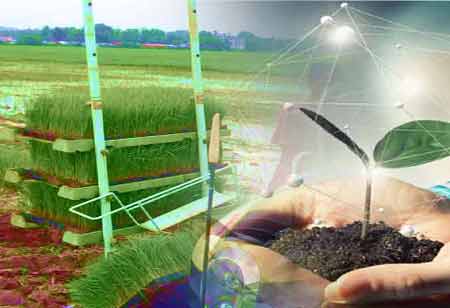Thank you for Subscribing to Agri Business Review Weekly Brief
Significance of Sustainable Agriculture
Sustainable agriculture plays a crucial role in feeding the expanding global population and mitigating the effects of climate change.

By
Agri Business Review | Friday, January 13, 2023
Stay ahead of the industry with exclusive feature stories on the top companies, expert insights and the latest news delivered straight to your inbox. Subscribe today.
Increasing food production and reducing global warming are made possible through sustainable agriculture, and sustainable production of food and fiber helps achieve both objectives. Environmentally friendly, sustainable agriculture practices protect Earth's resources, ensure soil fertility, and expand its natural resources.
FREMONT, CA: Sustainable agriculture plays a crucial role in feeding the expanding global population and mitigating the effects of climate change.
According to the World Bank, up to 30 percent of global greenhouse gas emissions are produced by agriculture today. Transportation, planting, harvesting, processing crops, and livestock production contribute to the agricultural infrastructure's emission output. Not to mention the water contamination caused by pesticides, herbicides, and fertilizers.
There is a need to lessen the environmental impact of agriculture while simultaneously increasing productivity to feed a growing global population. Those interested in this challenge and who wish to understand more about the significance of sustainable agriculture might consider furthering their education in a sustainability-related subject.
THE IMPORTANCE OF SUSTAINABLE AGRICULTURE
The global population is projected to increase from 7.7 billion today to 9 billion by 2050, while agricultural land is being lost to urban sprawl and climate change. According to the World Bank, food production must expand by 70 percent by 2050 to make up the deficit.
Herein lies the significance of sustainable agriculture. The United States Department of Agriculture defines sustainable agriculture as measures designed to safeguard the environment, increase the Earth's natural resource base, and maintain and improve soil fertility.
SUSTAINABLE AGRICULTURE BENEFITS
Some fundamental principles of sustainable agriculture can aid in reducing the environmental impact of farming. Among the benefits are the following:
Retaining carbon inside the soil: No-till farming keeps carbon in the soil rather than releasing it into the atmosphere. No-till farming requires the farmer to leave crop residue on the field after harvest rather than plow it under. It can extend to planting, in which the farmer scatters seed on the Earth rather than burying it. It also reduces the number of machines passing through a field.
Reducing pesticide, herbicide, and fertilizer usage: Crop rotation is the technique of rotating various crops in the same area to keep the soil healthy and productive by introducing a variety of nutrients. This can assist in reducing the need for pesticides and fertilizers for weed and insect control.
Upkeep of pastureland: Rotating grazing cattle from field to field creates soil from the animals' dung, enhancing the robustness of several pastures because the livestock does not deplete one field of grass. Additionally, it permits the soil to store more carbon.
Reducing fuel consumption: Planting perennial crops, also known as annuals, lowers the number of times a farmer must bring machinery into the field to plant and apply fertilizer.
These fundamental principles are essential for sustainable agriculture because they may be adopted on small farms in the US and other industrialized countries, as well as in agricultural settings in underdeveloped nations. The initial investment is cheap, and the return can be obtained rapidly.
TRENDS THAT WILL SHAPE THE FUTURE OF SUSTAINABLE AGRICULTURE
If not early adopters, farmers have consistently introduced technology to the field. Today, farmers use satellites to plow their fields, sensors to gather information about their soil, and sophisticated software to manage their operations.
Farm technologies increase agricultural yield by delivering more precise and timely field and weather data, reducing the need for fertilizers and pesticides, enhancing efficiency, and minimizing fuel consumption.
Important technologies for sustainable agriculture include the following:
Artificial Intelligence: Artificial intelligence (AI) systems analyze data to assist farmers in determining when and where to produce crops and feed livestock, as well as the optimal time to sell to maximize profits. Farmers may apply fertilizers more precisely and more time using data. The more information farmers have before planting, the more effectively they can manage resources and use fewer chemicals and fuel.
Biotechnology: Biotechnology is one of the oldest methods available to farmers for crop improvement. Over millennia, crossbreeding has developed hardier, higher-yielding plants and larger livestock.
The time required to crossbreed plants, adding or removing features to adapt to environmental conditions, has been shortened by current techniques created in the lab.
Although these approaches are contentious, proponents argue that crops can be made more productive, resistant to insects and disease, and more adaptable to local conditions, such as more severe droughts or higher levels of rainfall.
The new CRISPR gene editing technology can boost productivity and disease resistance by modifying certain features.
Drones: Farmers continue to discover new applications for drones that improve crop management. Initially, drones were used to spray herbicides on crops. Other emerging applications include taking aerial photographs to evaluate crops and capturing sensor data that can be mined to estimate crop health and weed population. In some instances, tree seeds for reforestation programs are dropped by drones.





